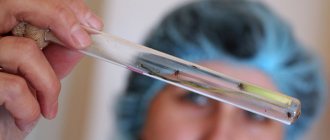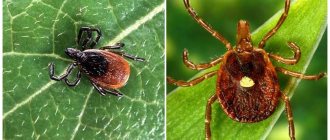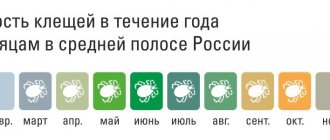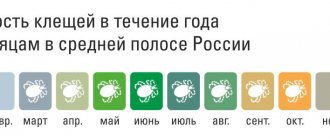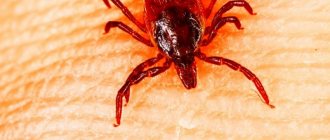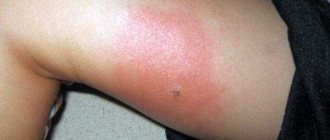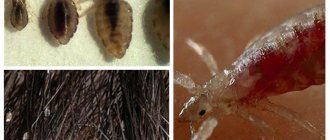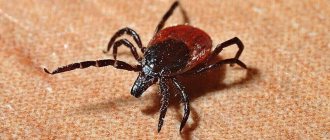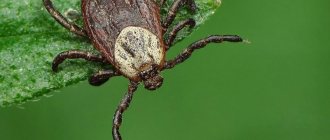Why are ticks dangerous?
Ticks are carriers of tick-borne viral encephalitis, tick-borne borreliosis and other diseases.
Tick-borne viral encephalitis is an acute infectious disease that primarily affects the central nervous system. This can lead to serious complications and even death. The causative agent of the disease is transmitted to humans in the first minutes along with the anesthetic saliva of the tick. The capital itself does not belong to the areas endemic for encephalitis, but the Dmitrovsky and Taldomsky districts of the Moscow region are recognized as such. This means that if you are bitten by a tick, there is a chance of contracting encephalitis.
But tick-borne borreliosis is widespread everywhere, including in the forests and parks of Moscow. Most patients develop skin lesions. Muscle and joint pain may also appear, the temperature may rise, and in severe cases, symptoms of meningitis, arthritis, hepatitis, and pericarditis may appear.
Actions in case of an insect bite
A person who has been bitten by a tick has only 96 hours from the moment the parasite was sucked on to prevent the consequences of the incident. Measures taken after this time interval will be ineffective. Actions in the event of a tick bite should be carried out quickly, but calmly, in order to prevent the infected proboscis from being separated from the body of the insect.
The first priority when detecting an attached parasite is to remove it as quickly as possible, but performing rescue procedures on your own is highly not recommended. A common consequence of trying to remove a tick on your own is infection with tick-borne infections (encephalitis, babesiosis, borreliosis, tularemia, etc.) or acariasis (dermatitis, scabies, ixodiasis).
- Officials lifted the ban on the installation of used spare parts
- Travel insurance abroad for adults, children and pregnant women - the best companies and cost of the policy
- Why is revaccination necessary?
The algorithm for emergency actions aimed at avoiding infection consists of sequentially performing the following steps:
- Go to the emergency department of the medical institution specified in the insurance policy. If you do not have insurance, you must contact the clinic at your place of registration or the emergency department (if the incident occurred on a non-working day). The documents that you should take with you are a compulsory medical insurance or voluntary medical insurance policy, a life and health insurance contract (if available), an identity card (passport, driver’s license).
- Submit the tick that has been removed or detached on its own to a research laboratory for testing to detect infections. If you have insurance, the study of the biting parasite is included in the list of guaranteed free services; if not, it is carried out on a paid basis.
- Donate blood (venous) for a serological test to determine whether the infection was transmitted from a tick to a person. Research results are delivered no later than 3 days from the date of application, but in emergency cases they are prepared within 1 day.
- Carry out seroprophylaxis (administration of injections of immunoglobulin - donor blood containing specific antibodies). The need for preventive measures arises if positive results of laboratory blood tests are obtained or if it is impossible to promptly diagnose the presence of infections.
- 8 Foods That Detoxify Your Body
- 5 diseases that cause excess weight
- Why you shouldn't start your day with coffee
How to avoid a tick bite
When going to the forest, treat your clothes with tick repellent in advance. It is better to choose high shoes that cover your heels and ankles, and socks should have thick elastic. Trousers must be tucked into boots, and a jacket, T-shirt or shirt into trousers. Sleeve cuffs should be buttoned. Be sure to put a cap, scarf, panama hat or hood on your head. Choose light-colored clothing: this makes it easier to spot the tick.
Ticks stick tightly only an hour and a half after contact with the skin, and where it is thinner and more delicate: behind the ears, on the neck, under the arms, on the scalp. Therefore, examine yourself and your companions at least once an hour.
Experts advise treating summer cottages with acaricidal, that is, tick-killing agents. They remain effective for up to 45 days. Treatment can be carried out along the perimeter of the territory, on the paths leading to the site. Make sure that the product does not get on the beds or in water containers.
Prevention measures
It is easier to prevent any problem. Every person has a risk of contracting encephalitis. Therefore, it is advisable to get vaccinated - only it will protect against the development of the disease. When visiting endemic areas you should:
- complete the full course of vaccination;
- You need to get vaccinated no earlier than three weeks before the trip;
- It is advisable to limit visits to forests for two weeks, since during this time immunity is developed.
Pre-exposure prophylaxis is allowed. It involves the administration of immunoglobulin before traveling to areas unfavorable for encephalitis. The drug begins to act after two days. Its effectiveness lasts for four weeks. But even in this case, the protective effect of immunoglobulin is much lower than that of the vaccine.
Ticks have been active since April. The maximum number of arthropods is observed in the first half of summer. It is easiest to meet them in dry and sunny weather. They are located on grass or low bushes. Ticks are attracted to the smell of animals and humans. They attack very simply. When someone passes nearby, the arthropod clings to the fur or clothing with its paws. Then it crawls up to the skin and digs in. It is attached in inconspicuous places: groin, hair and others. Therefore, it is not so easy to detect.
Not every tick is a carrier of encephalitis or borreliosis. But this does not exclude the need to consult a doctor, since in such situations it is better to be safe. Purchasing a special policy will save time and money. It is inexpensive and includes the full range of services: arthropod extraction, its examination and preparation of the preparation. It is necessary to get vaccinated in the spring, as it is the most effective way of protection.
What should I do if bitten by a tick
The main rule is to immediately go to the nearest emergency room. Doctors will provide qualified assistance and decide whether specific immunoglobulin needs to be administered. It is indicated if you were bitten by a tick in an area where this disease is endemic, and you are not vaccinated against tick-borne viral encephalitis or have received less than two vaccinations.
Immunoglobulin is administered in the first 96 hours after the bite. This can be done and the tick removed in emergency rooms. Children will also be accepted at any time of the day at Children's Clinical Hospital No. 13 named after Filatov (Sadovaya-Kudrinskaya Street, building 15; telephone). Adults, in addition to the emergency room, can go to Infectious Diseases Clinical Hospital No. 2 (8th Sokolinaya Gora Street, 15; telephone numbers,,).
If you can’t get to a doctor, you’ll have to remove the tick yourself. Unscrew it using gentle rotational movements. Another option is to bring the thread under the abdomen and tie it in a knot, pull, slowly rotating and trying not to tear the abdomen away from the proboscis with jaws. After removal, the wound should be lubricated with alcohol or iodine. But if possible, it is better to seek help from doctors.
The tick should be placed in a clean glass jar with a damp cotton wool or napkin and sent for analysis to the laboratory. It is examined for the presence of the encephalitis virus or the causative agent of borreliosis at the Center for Hygiene and Epidemiology, which is located in Grafsky Lane, building 4/9 (telephones).
Cost of the study
After an attack by a parasite, testing for encephalitis is mandatory for all victims. In addition to the main analysis, it is recommended to donate blood for serological diagnosis of borreliosis (immunochip) to obtain an accurate picture of the consequences of the bite. The average cost required for timely detection of hazardous consequences is:
| Types of research | Price, rub. |
| Research on: | |
| Borreliosis | 593-890 |
| Encephalitis | 250-430 |
| Blood test for antibodies (tick-borne encephalitis and Lyme borreliosis): | |
| IgG | 438-1060 |
| IgM | |
How to protect your pets from ticks
Ticks carry diseases that are also dangerous for domestic animals. Among them is piroplasmosis, which can cause death in dogs. Veterinarians advise owners to treat their four-legged pets with special products with the arrival of spring. These can be repellents that repel ticks, or products that destroy them. There are also drugs that do both. Keep in mind that products for dogs are not suitable for cats and vice versa.
If you notice a parasite that has already attached itself, try to carefully remove it. If you do not know how to do this correctly or are afraid, urgently take the animal to the veterinary clinic. A list of state veterinary clinics is available on the website of the Veterinary Committee. Information about private specialists can be found on the open data portal.
general information
Some people are quite negligent about their health. Arthropod bites do not frighten them, since people do not always imagine the consequences of their indifference. Tick-borne encephalitis is becoming more common every year. Borreliosis is no less dangerous. These infectious diseases often lead to death or severe disability.
The likelihood of disease depends on how long the tick was in the attached state. Therefore, if an embedded arthropod is found on the body, it must be quickly removed. Initial consultation is provided by calling 103 - this is the ambulance control room. Most likely, the operator will send you to the regional emergency room or to the SES. Not everyone knows where ticks are removed in Moscow; this can be done in any medical institution.
But it is not always possible to quickly get to the hospital. In this case, you need to remove the tick yourself. For this use:
- curved tweezers;
- surgical clamp;
- special device.
To remove an arthropod, you need to hold it closer to the proboscis and carefully pull it out, rotating it around its axis. Usually one or two turns is enough. You should try not to make sudden jerks, as this will lead to the head being torn off. In this case, it will remain in the wound, which will lead to inflammation.
Special devices are preferable for use. They do not squeeze the tick’s body, which prevents the contents from being squeezed out into the blood. You can try to remove the arthropod using a thread. The noose is placed over his head, tightened and pulled gently.
Structural features of the tick's nutritional organs
Once it has attached itself to an object with sharp claws at the ends of its legs, the tick bites into the victim. The oral apparatus is very complex in structure, performing several functions at once, providing blood flow and at the same time additionally fixing the ectoparasite on the skin of a person or animal. That is why difficulties arise with how to get a tick from a person without damaging the insect itself and without provoking the release of its saliva. The proboscis is covered with spines; they prevent the pest from being easily removed by getting stuck in the skin. You cannot try to pull out the parasite with a jerk, this is useless and dangerous, especially since during the feeding process not only the proboscis and the first pair of chelicerae are immersed in the epidermis, but also the head of the blood-sucking insect, for which purpose the upper stratum corneum is first cut through.
Important: the mite is able to regulate the depth of penetration of the proboscis into the skin. The deeper it goes, the more difficult it is to figure out how to remove a tick from a person on your own, without a threat to health, since the chance of developing inflammatory processes increases.
Actions to take if bitten by a tick
Human infection with tick-borne borreliosis occurs through the bite of an infected tick.
Ticks transmit the bulk of pathogens in the first minutes of the bite along with the first portion of anesthetic saliva. Infection with tick-borne borreliosis is also possible when a tick is crushed during the process of removing it from animals or the human body, with subsequent introduction of the virus to the mucous membranes of the eyes, nose and lips or to damaged areas of the skin. If a tick has attached itself to a person’s skin, it should be removed especially carefully so as not to tear off the proboscis, which is deeply and strongly strengthened for the entire period of suction.
When removing a tick, the following recommendations must be followed:
- grab the tick with tweezers or fingers wrapped in clean gauze as close to its oral apparatus as possible and holding it strictly perpendicular to the surface of the bite, rotate the tick’s body around its axis, remove it from the skin;
- disinfect the bite site with any suitable product (70% alcohol, 5% iodine, cologne, etc.);
- after removing the tick, you must wash your hands thoroughly with soap;
- the removed tick should be burned or poured with boiling water;
- if the head or proboscis of a tick is torn off (accidentally or during its removal), a black dot remains on the skin, which must be treated with 5% iodine and left until natural elimination.
Ticks removed from the skin can be delivered to a laboratory, where they are tested for Borrelia infection in compliance with the following rules:
1. Only live ticks are suitable for research.
2. Do not lubricate ticks with oils, creams, etc.
3. The removed tick should be placed in a clean container (test tube, vial, jar, etc.), into which, in order to create increased humidity, pre-place absorbent paper slightly moistened with water (filter paper, paper napkin, etc.).
4. Storage and delivery of ticks in compliance with the above conditions is possible only within 2 days.
For examination, removed live ticks can be sent to the Federal Center for Hygiene and Epidemiology (Federal State Institution of Health and Safety of Rospotrebnadzor) at the address: Varshavskoye Shosse, building 19-a, Laboratory of Particularly Dangerous Infections of the Laboratory Affairs Department, tel., as well as to the Federal State Institution "Center for Hygiene and Epidemiology" in Moscow" - department of medical parasitology of the epidemiological department - study of ticks for infection with borrelia (address: Moscow, Grafsky per. 4/9, tel. +7 (495) 687-62-84); department of especially dangerous infections of the microbiological laboratory - examination of ticks to detect antigen to the tick-borne encephalitis virus (address: Moscow, Grafsky per. 4/9, tel.).
Memo for the population
Ixodid tick-borne borreliosis (TBB) is a transmissible natural focal infection with an acute or chronic course. The causative agent is the spirochete Borrelia burgdorferi; 12 genotypes of the pathogen are currently described.
Many species of small mammals, ungulates, and birds are reservoirs of the pathogen and “feeders” of ticks. Human susceptibility to Borrelia is very high. Cases of disease are reported among all age groups; the working-age adult population gets sick more often. Clinically, tick-borne borreliosis is characterized by a polymorphism of manifestations: damage to the skin, nervous and cardiovascular systems, musculoskeletal system, general infectious intoxication, and often acquires a chronic and relapsing course. Infection in endemic areas is possible from March-April to September-October, the most dangerous time being May and June.
The causative agent of the disease is transmitted to a person in the first minutes of the bite of a Borrelia-infected tick along with anesthetic saliva.
Infection of the population is possible:
- when visiting areas endemic for tick-borne borreliosis in forests, forest parks, and individual garden plots;
- when ticks are introduced by animals (dogs, cats) or people - on clothes, with flowers, branches, etc. (infection of people who do not visit the forest);
- when removing, crushing a tick or scratching the bite site, infection with tick-borne borreliosis can also occur as a result of rubbing the infectious agent into the skin with saliva or tick tissue;
- when consuming raw milk from goats (most often), cows and buffaloes, in which Borrelia may be present in the milk during a period of mass tick attacks. Therefore, in areas unfavorable for tick-borne borreliosis, it is necessary to consume this product only after boiling.
The incubation (hidden) period ranges from 1 to 30 days (usually 7-14 days), the accuracy of which depends on the accuracy of establishing the fact of tick suction. The disease usually begins acutely or subacutely with the appearance of pain, itching, swelling and redness at the site of the tick bite. Patients complain of moderate headache, general weakness, and malaise. Body temperature rises, often up to 38 degrees C. At the same time, characteristic skin erythema appears (in 70-90% of cases). It gradually increases in size from the center to the periphery, reaching a diameter of 3 to 68 cm. Sometimes, several red rings are surrounded by one common one.
Tick-borne encephalitis can be prevented using nonspecific prophylaxis. The main goal of nonspecific prophylaxis is to prevent tick bites.
Nonspecific prevention includes the use of:
- special protective suits (a suit for protection against midges and ticks, consisting of a “knitted protective technical set” TU 17 - RSFSR-53-10-435-82 (over and under mesh shirts and a head cape) or a “men’s summer suit for workers — forestry workers, protective against insects" TU 17 — RSFSR-06-76-94-81 (trousers, jacket));
- adapted clothing, which should not allow ticks to crawl through the collar and cuffs. Pants should be tucked into boots, knee socks, and socks with tight elastic. The upper part of clothing (shirt, jacket) should be tucked into trousers, and the sleeve cuffs should fit snugly to the arm. The collar of shirts and trousers should not have a fastener or have a zipper type fastener, under which a tick cannot crawl. On the head, it is preferable to wear a helmet-hood, tightly sewn to the shirt; in extreme cases, the hair should be tucked under a scarf. Clothes should be plain, as ticks are more visible on them. Keep in mind that ticks always crawl up clothing, obeying negative geotaxis!;
- special chemicals applied to clothing to protect against tick attacks and reduce the risk of infection. Only funds registered on the territory of the Russian Federation in accordance with the established procedure should be used. The effectiveness and safety of these drugs depends on compliance with the recommendations for the methods of their use indicated on the label or in the “Guidelines” for each product. In this case, a mandatory condition is compliance with precautions, personal hygiene, and in case of poisoning - first aid. Preparations containing insecticides are applied only to clothing; their use on the skin is prohibited!
List of drugs approved in the Russian Federation for protection against ticks
| No. | Name of the drug | Manufacturer |
| 1. | "Biban" | Slovenia |
| 2. | "DEFI-Taiga" | Russia |
| 3. | “Off! Extreme" | Italy |
| 4. | "Gardex aerosol extreme" | Italy |
| 5. | "Gal-RET" | Russia |
| 6. | "Gal - RET - cl" | Russia |
| 7. | "Deta-WOKKO" | Russia |
| 8. | "Reftamid maximum" | Russia |
| 9. | "Pretix" - block | Russia, PBOYUL P.N. Dobronravov |
| 10. | "Reftamid taiga" (aerosol) | Russia, JSC "Sibiar" |
| 11. | "Picnic - Antiklesch" (aerosol) | Russia, JSC "Arnest" |
| 12. | "Tornado - Antiklesch" (in propellant-free aerosol packaging) | Russia Moscow |
| 13. | "Fumitox - anti-mite" (aerosol) | Russia Moscow |
| 14. | "Gardex - anti-mite" (aerosol) | Italy, |
| 15. | "Permanon" (aerosol) | Russia |
| 16. | "Kra-rep" (aerosol) | Russia, JSC "Khiton" |
| 17. | "Moskitol - anti-mite" (aerosol) | France, FCA |
Each person, being in a natural focus of tick-borne borreliosis during the active season of insects, should often (every 10-15 minutes) conduct superficial inspections of his clothing, and every 2 hours it is necessary to conduct thorough examinations of the body, removing and turning out clothes. In dangerous territory, you should not sit or lie down on the grass, or it is necessary to carry out self- and mutual inspections of clothing especially often and carefully. To choose a parking place or overnight stay, dry pine forests with sandy soil or areas devoid of herbaceous vegetation are preferred. Before spending the night, you should carefully inspect your clothing, body and hair. After returning from the forest, conduct a full examination of the body and clothing. Do not bring freshly picked flowers, branches, outerwear or other items into the room that may contain ticks.
Don’t forget that ticks usually don’t stick right away! The faster the tick is removed from the body, the smaller the dose of the pathogen it will transmit! A tick attached to the body must be removed immediately after detection, being careful not to tear off the proboscis immersed in the skin, and contact a medical facility. To remove an attached tick, you need to grab it with tweezers or fingers wrapped in clean gauze as close to the oral apparatus as possible and, holding it strictly perpendicular to the surface of the bite, turn the tick’s body around its axis and remove it from the skin. The removed tick should be burned or poured with boiling water. It is recommended to treat the wound at the site of the bite with iodine and wash your hands thoroughly.
Symptoms of encephalitis
Tick-borne encephalitis is a seasonal viral disease. Encephalitis enters the human body after being bitten by an infected tick or by consuming milk from infected cows or goats.
On average, clinical signs of the disease appear a month after an encephalitis tick bite.
Depending on the manifestation of symptoms, tick-borne encephalitis develops in 3 forms:
- focal form - observed in 20% of patients;
- febrile form - occurs in 50% of patients;
- meningeal form - in 30%.
In the focal form of tick-borne encephalitis (the most severe form of the disease), the infection penetrates into the substance of the spinal cord and brain. The following signs of a tick bite are observed: chills, convulsions, severe fever (above 40 degrees), lethargy and drowsiness.
Depending on what part of the brain or spinal cord is affected, symptoms such as delusions, hallucinations, cardiac and respiratory disorders, paralysis and paresis of the shoulder and neck muscles, impaired voluntary movements, etc. may be present.
The febrile form of encephalitis lasts up to 10 days. The disease has a wave-like character, then subsiding, then appearing again in the form of fever. But weakness, palpitations and sweating persist for a long time.
Menigeal form . In this form of the disease, inflammation of the membranes of the spinal cord and brain occurs. For 2 weeks, the patient experiences severe headache (for which pills do not help), neck tension, vomiting, fever, and fever.
